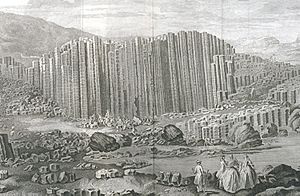Susanna Drury facts for kids
Quick facts for kids
Susanna Drury
|
|
|---|---|

Engraving of Drury's A View of the Giant's Causeway: East Prospect
|
|
| Born | c. 1698 |
| Died | c. 1770 |
| Nationality | Irish |
| Known for | painting |
Susanna Drury, who later became Susanna Warter (born around 1698 – died around 1770), was an important Irish painter. We don't know a lot about her life or her other artworks. However, she played a big part in how landscape painting grew in Ireland. She is most famous for her amazing watercolor drawings of the Giant's Causeway in County Antrim. These drawings helped people all over the world learn about this special place.
Who Was Susanna Drury?
Susanna Drury was born around the year 1698. She was connected with the Royal Dublin Society, a group that helps with arts and sciences. In 1740, this society gave her its very first award, which was worth £25. She earned this award for her beautiful paintings of the Giant's Causeway.
To make her drawings, Susanna traveled to Ulster in Northern Ireland. She spent several months there, carefully studying the Giant's Causeway up close. This helped her capture every detail of the natural wonder.
Her Famous Causeway Paintings
Susanna's drawings were made using a special type of paint called gouache (pronounced gwahsh). This paint is like watercolor but thicker and more opaque. She painted on vellum, which is a fine, smooth material often made from animal skin.
Her two most famous paintings show the Giant's Causeway from different angles: one from the east and one from the west. These artworks are very accurate. They show the unique, many-sided basalt columns that make up the Causeway. These columns look like giant, natural stepping stones.
Susanna's paintings made the Giant's Causeway famous. After her work, many other artists started painting Irish landmarks. This made "monument paintings" very popular in Ireland.
How Her Art Spread Worldwide
Because her paintings were so important, other artists made engravings of them. An engraving is a print made from a design carved into a metal plate. A French artist named François Vivares created these engravings between 1743 and 1744.
Prints made from these engravings became very popular across Europe. Scientists also shared them widely. In 1765, the Giant's Causeway was even included in a famous French book called the Encyclopédie. The information in this book clearly came from Susanna Drury's engravings.
One of the engravings of her "East Prospect" painting even appeared in the Encyclopédie without her name on it. It was in the geology section, next to pictures of similar rock formations in France. A scientist named Nicolas Desmarest wrote a caption for it. He suggested, for the first time in print, that these amazing rock structures were formed by volcanoes.
Susanna Drury later married a man named Warter. She passed away in or after the year 1770. Today, her original gouache drawings of the Giant's Causeway are kept in the Ulster Museum in Belfast.

